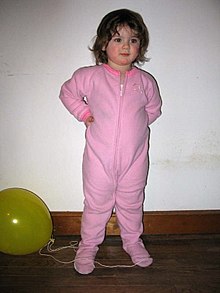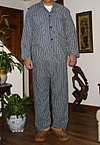| Revision as of 23:37, 20 November 2008 editStr1977 (talk | contribs)Extended confirmed users, Pending changes reviewers59,126 editsNo edit summary← Previous edit | Revision as of 23:45, 20 November 2008 edit undoFowler&fowler (talk | contribs)Autopatrolled, Extended confirmed users, File movers, Pending changes reviewers, Rollbackers63,079 edits rv undiscussed changes by str1977; all spelling differences in article titles are dealt with this way; this article has been stable for over two years, please bring up issues on talk page firstNext edit → | ||
| Line 1: | Line 1: | ||
| ⚫ | ]) wearing pyjamas.]]] in pyjamas.]]] | ||
| {{wiktionary}} | {{wiktionary}} | ||
| '''Pyjamas''' (spelled '''pajamas''' in ]<ref>See ]</ref>) are a type of mostly two-piece ] or garments derived from the preceding, such as women's beach pyjamas. | |||
| ⚫ | ]) wearing pyjamas.]]] in pyjamas.]]]'''Pyjamas''' or '''pajamas''' (see also ]) is a word with several different, related meanings in the field of ]. | ||
| ⚫ | The |
||
| ⚫ | * The original ''pyjamas'' — are loose, lightweight drawstring trousers tied around the waist and worn in ] and ].<ref>cf. ''The Oxford English Dictionary''. 1989 edition. Oxford University Press. Oxford and London.</ref> | ||
| ⚫ | When referring to sleepwear, ] or ] forms of the word are often used, such as '''pjs''' or '''jammies'''. | ||
| ==Types== | |||
| * A loose, two-piece garment derived from the preceding garment, is worn as (especially men's and boys') ], in ], the ], and other countries. Pyjamas in this sense consist of a ] and trouser combination, made of a lightweight non-stretch material, similar to materials used in ]s, with the jacket closing down the front with ]s. These first appeared in Britain as a result of ] in ] in the 18th and 19th centuries, and by the early 20th century had replaced ]s as the dominant style of sleepwear for men and boys there. (In South Asia these are known as ''night suits''.) | * A loose, two-piece garment derived from the preceding garment, is worn as (especially men's and boys') ], in ], the ], and other countries. Pyjamas in this sense consist of a ] and trouser combination, made of a lightweight non-stretch material, similar to materials used in ]s, with the jacket closing down the front with ]s. These first appeared in Britain as a result of ] in ] in the 18th and 19th centuries, and by the early 20th century had replaced ]s as the dominant style of sleepwear for men and boys there. (In South Asia these are known as ''night suits''.) | ||
| * Other garments are derived from the preceding garment, such as women's beach pyjamas. | |||
| * (Chiefly American) any of a wide variety of (mostly two-piece) sleeping garments are worn by both genders, including the aforementioned jacket and trouser combination, but also including many unrelated styles. In particular, many of these (especially ones for children) are made of stretch knit fabrics of various weights and thicknesses, with ] trimmings, and tops that are pulled over the head like a ]. (See also '']s'', also known as ''footed pyjamas''.) Although a distinction is often made between ''pyjamas'' and non-] sleeping garments such as ]s, some speakers in the U.S. include even the latter within the definition of ''pajamas''. | * (Chiefly American) any of a wide variety of (mostly two-piece) sleeping garments are worn by both genders, including the aforementioned jacket and trouser combination, but also including many unrelated styles. In particular, many of these (especially ones for children) are made of stretch knit fabrics of various weights and thicknesses, with ] trimmings, and tops that are pulled over the head like a ]. (See also '']s'', also known as ''footed pyjamas''.) Although a distinction is often made between ''pyjamas'' and non-] sleeping garments such as ]s, some speakers in the U.S. include even the latter within the definition of ''pajamas''. | ||
| The word "pyjama" was incorporated into the English language from ] (the progenitor language of modern-day ] and ]). The word originally derives from the ] word پايجامه ''Payjama'' meaning "leg garment." | |||
| ⚫ | When referring to sleepwear, ] or ] forms of the word are often used, such as '''pjs''' or '''jammies'''. | ||
| ==History== | ==History== | ||
Revision as of 23:45, 20 November 2008



Pyjamas or pajamas (see also spelling differences) is a word with several different, related meanings in the field of clothing.
- The original pyjamas — are loose, lightweight drawstring trousers tied around the waist and worn in South and West Asia.
- A loose, two-piece garment derived from the preceding garment, is worn as (especially men's and boys') sleepwear, in Britain, the United States, and other countries. Pyjamas in this sense consist of a jacket and trouser combination, made of a lightweight non-stretch material, similar to materials used in bed sheets, with the jacket closing down the front with buttons. These first appeared in Britain as a result of British colonial presence in South Asia in the 18th and 19th centuries, and by the early 20th century had replaced nightshirts as the dominant style of sleepwear for men and boys there. (In South Asia these are known as night suits.)
- Other garments are derived from the preceding garment, such as women's beach pyjamas.
- (Chiefly American) any of a wide variety of (mostly two-piece) sleeping garments are worn by both genders, including the aforementioned jacket and trouser combination, but also including many unrelated styles. In particular, many of these (especially ones for children) are made of stretch knit fabrics of various weights and thicknesses, with rib-knit trimmings, and tops that are pulled over the head like a t-shirt. (See also blanket sleepers, also known as footed pyjamas.) Although a distinction is often made between pyjamas and non-bifurcated sleeping garments such as nightgowns, some speakers in the U.S. include even the latter within the definition of pajamas.
The word "pyjama" was incorporated into the English language from Hindustani (the progenitor language of modern-day Urdu and Hindi). The word originally derives from the Persian word پايجامه Payjama meaning "leg garment."
When referring to sleepwear, abbreviated or diminutive forms of the word are often used, such as pjs or jammies.
History
The worldwide use of pyjamas and the word and the garment is the result of British colonial presence in South Asia in the 18th and 19th centuries. According to Yule and Burnell's Hobson-Jobson (1903) the word originally referred to loose trousers tied around the waist.
Such a garment is used by various persons in India e.g. by women of various classes, by Sikh men, and most by Muslim of both sexes. It was adopted from the Muslim by Europeans as an article of dishabille and of night attire ... It is probable that we English took the habit like a good many others from the Portuguese. Thus Pyarard (c. 1610) says, in speaking of Goa Hospital: "Ils ont force calsons sans quoy ne couchent iamais les Portugais des Indes" ... The word is now used in London shops. A friend furnishes the following reminiscence: "The late Mr. B—, tailor in Jermyn Street, some 40 years ago, in reply to a question why pyjammas had feet sewn on to them (as was sometimes the case with those furnished by London outfitters) answered: 'I believe, Sir, it is because of the White Ants." Examples. 1828: "His chief joy smoking a cigar in loose Paee-jams and native slippers." Orient. Sport. Mag. reprint 1873, i. 64. 1881: "The rest of our attire consisted of that particularly light and airy white flannel garment, known throughout India as a pyjama suit." Haekel, Ceylon, p. 329.
 |
 |
 |
According to Encyclopaedia Britannica, "They were introduced in England as lounging attire in the 17th century but soon went out of fashion. About 1870 they reappeared in the Western world as sleeping attire for men, after returning British colonials brought (them) back ...."
Material

Pyjamas are usually loose fitting and designed for comfort, using softer materials such as cotton or the more luxurious silk or satin. Synthetic materials such as polyester and Lycra are also available. They are usually worn with bare feet and often without underwear, although these vary by personal preference.
Designs and Patterns
Pyjamas often contain visual references to a thing that may hold some special appeal to the wearer. Images of sports, animals, balloons, polka dots and other things may all be used to decorate them. Pyjamas may also be found in plainer designs, such as plaid or plain gray, but when worn in public, they are usually designed in such a way that makes their identity unambiguous.
Custom

Pyjamas are often worn as comfort wear even when not in bed, and are also sometimes worn as a fashion statement. In North America, some people (mainly young females) have started to wear pyjama pants in public as fashion. In China, it is not unusual in the late afternoon or evening, to have adults wear their pyjamas in public around their local neighborhood.
References to Pyjamas in Popular Culture
The Pajama Game was a Broadway musical and film highlighting workers at a pyjama factory.
Pyjamas played a prominent role on a popular kids television show known as Bananas in Pyjamas. The show detailed the adventures of two bananas while wearing their pyjamas.
Pajamas Media is an online advertising and publishing company created by bloggers Roger L. Simon and Charles Johnson. The term derives from CNN president Jonathan Klein's 2004 dismissal of bloggers as "a guy sitting in his living room in his pyjamas.".
Notes
- cf. The Oxford English Dictionary. 1989 edition. Oxford University Press. Oxford and London.
- Lewis, Ivor. 1991. Sahibs, Nabobs and Boxwallahs: A Dictionary of Words of Anglo-India. Oxford: Oxford University Press. 266 pages. ISBN 0195642236.
- Yule, Henry and A.C. Burnell. 1903. Hobson-Jobson: A Glossary of Colloquial Anglo-Indian Words and Phrases, and of Kindred Terms, Etymological, Historical, Geographical and Discursive. London: John Murray. 1021 pages.
- According to Hobson-Jobson, "The insect (Termes bellicosus of naturalists) not properly an ant, of whose destructive powers there are in India so many disagreeable experiences, and so many marvellous stories."
- pyjamas. (2006). In Encyclopædia Britannica. Retrieved December 29, 2006, from : Encyclopædia Britannica Online.
- Three Political Web Logs Make a Run for the Mainstream, Roderick Boyd, The New York Sun, May 3, 2005. Accessdate: April 16, 2008.
See also
| Clothing | |||||||||
|---|---|---|---|---|---|---|---|---|---|
| Headwear | |||||||||
| Neckwear | |||||||||
| Underwear and lingerie |
| ||||||||
| Tops | |||||||||
| Bottoms |
| ||||||||
| Full-Body Wear |
| ||||||||
| Coats and outerwear |
| ||||||||
| Nightwear | |||||||||
| Swimwear | |||||||||
| Legwear | |||||||||
| Footwear | |||||||||
| Accessories |
| ||||||||
| Dress codes |
| ||||||||
| Related | |||||||||